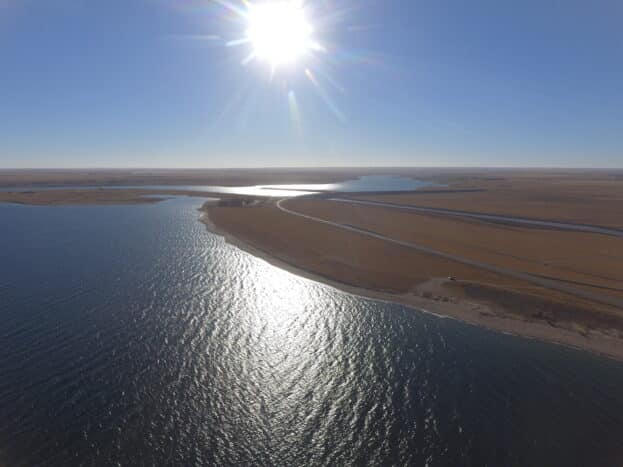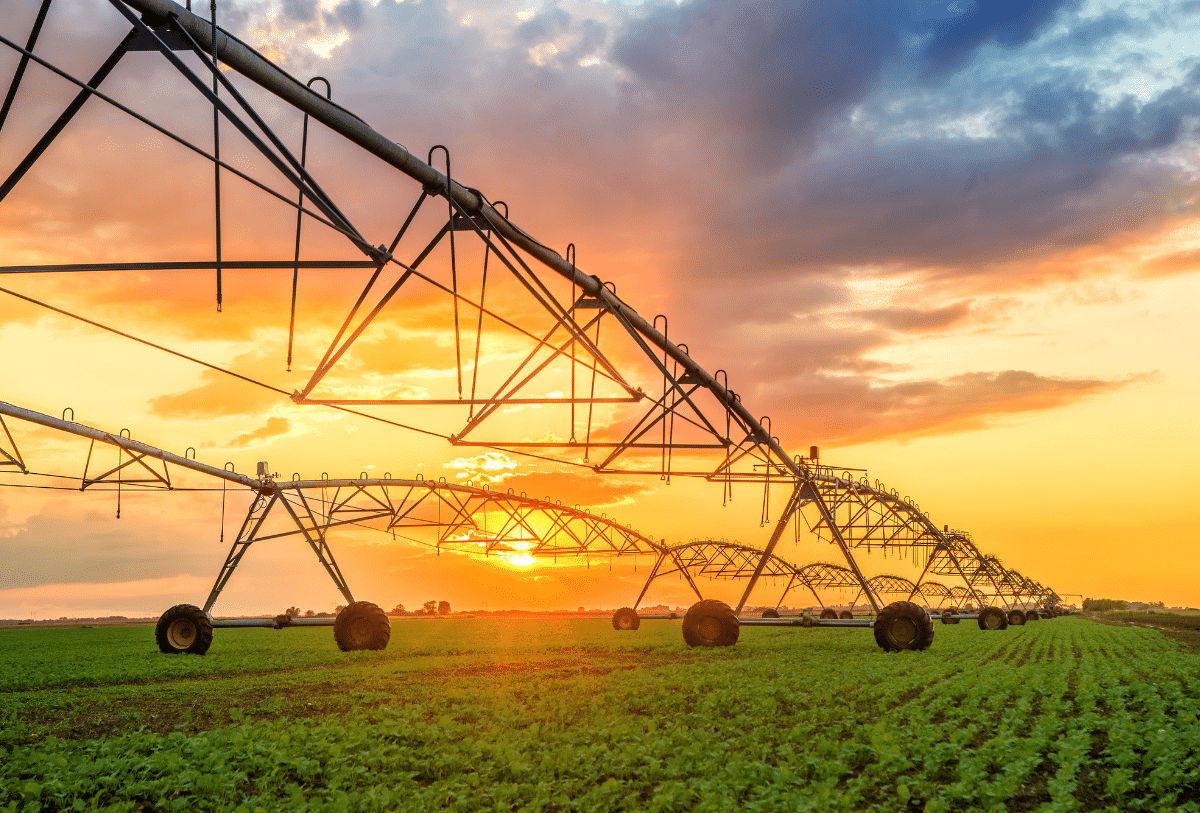Saskatchewan is nearing the construction stage as its irrigation expansion is set to begin.
Saskatchewan’s potato industry has 500,000 reasons to celebrate, and they probably won’t mind the wait given the history. A $4 billion, three-phase irrigation expansion near Lake Diefenbaker was announced in summer 2020 and continues to inch closer to seeing shovels in the ground. Pre-construction work including consultations, surveying and engineering work is nearing completion on the first of the three expansion projects. As the single biggest infrastructure development in Saskatchewan history, the Lake Diefenbaker Irrigation Projects expansion will create half-a-million irrigable acres and, most assuredly, boost potato production — and no, we won’t talk about SPUDCO.
Saskatchewan is a quality environment to grow seed potatoes due to long sunny days coupled with short cool nights, a largely disease-free environment and notable northern vigour. This is good news for the 16 commercial seed and fresh market potato growers looking to expand their business. It’s similarly good news for soon-to-be potato growers, as well.

One seed potato grower who is massively excited about this expansion is Matthew Lawless, partner and operations manager at Barrich Farms and True North Seed Potato Co. at Outlook, Sask. He’s also the current president of the Saskatchewan Seed Potato Growers Association.
Where he works east of Outlook his irrigation water comes directly from Lake Diefenbaker via the South Saskatchewan River Irrigation District No. 1 (SSRID). As the largest and one of the oldest irrigation districts in the province, SSRID is comprised of 485 kilometres of canals, laterals and drains along with another 60, split between gravity and pressurized pipelines. Although the initial phase occurs on the west side of the South Saskatchewan River, landowners will still benefit from its completion. Lawless notes the broader community invariably benefits from these projects as substantial amounts of money are invested in the community and region, such as irrigation and municipal infrastructure and general purchases throughout nearby towns. The first phase one of the build-out is the completion of the western side of Lake Diefenbaker, which was largely abandoned in the 1970s.

“The government has been working hard the last couple of years to put a plan in place and execute on preliminary engineering and consultation processes to bring that project to fruition,” he says. “The farming community in this area, the industrial and irrigation community and just the consumers are massively in favour of this expansion going forward.”
While there’s no timeline for completion, Lawless does expect the entire project to be completed before his career is over.
He also believes this time will be different. With strong political signals to get this project off the ground, many see it as a non-partisan issue. Lawless says it’s in the best interest of not only Saskatchewanians, but all Canadians, to get this done.
“There’s plenty of arable land in Saskatchewan that is prime for irrigation,” he says. “We can contribute to the nation’s food security in a much more impactful way through irrigation.”
And it’s not just seed potato growers that can be excited, but anyone working in agriculture looking to produce crops under irrigation. By the time all three phases are complete, Lawless is confident the province’s potato growers could double in number.
The pre-work is coming together through the Water Security Agency (WSA), a Treasury Board Crown corporation of the government.
According to its director of irrigation Joel Peru, developing more irrigable acres is part of the Saskatchewan’s long-term growth plan. Since 2020, 34,000 acres of irrigation has been developed, not including an estimated 20,000 in 2023. Across the entire province, 407,000 acres are under irrigation, which includes back flood irrigation areas, primarily in the southwest part of the province.

Part one of the project on Lake Diefenbaker —which is two separate phases— will create 340,000 new irrigable acres. The third and final phase, the Qu’Appelle Valley Conveyance, will add the final 160,000. No preliminary work has yet been done on phase three.
Of all potatoes grown in Saskatchewan in 2022, the number grown under irrigation was 5,200 acres. It fluctuates between 3,000 and 5,000 most years, says Peru. This project, however, will increase averages across the board as there will be more land available to incorporate potato production into crop rotation.
“Having more irrigated acres around Lake Diefenbaker is going to help move towards critical mass and allow more ground to be available for potato production,” he says.
As part of phase one, rehabilitating the existing Westside canal that runs from Lake Diefenbaker to the Conquest Reservoir will be important. The first phase will add 80,000 acres of irrigation capacity. Beyond that, the existing Westside Pump Station will have to be built to provide the required water supply.
Phase two is all about expansion, namely adding another 260,000 acres in central Saskatchewan to irrigation. New canals and reservoirs will be required, and this phase will add a staged, long-term benefit to the province.
According to Lake Diefenbaker Irrigation Projects, one acre of dryland wheat adds $400 to Saskatchewan’s GDP, but one irrigated acre of potatoes is worth $5,500. That same acre dedicated to processing potatoes is worth $20,000. Could this expansion attract a Saskatchewan-based processer? Time will tell.
The expansion is predicted to bring in $4.6 billion annually in tax revenues and provide 2,500 jobs per year during the building phase.
The WSA is also working on the Saskatoon Southeast Water Supply System, and it recently announced 15,000 more acres of irrigation in that area, most of which was immediately snapped up by farmers.
“We’re trying to identify more opportunities to go there because it is using an existing infrastructure,” says Peru. “We know that there is producer interest there as well.”
All farmers that applied for water licences from that announcement have been given the green light. Peru expects in 2024 producers will develop their infrastructure to take advantage of the water allocations.
For the Lake Diefenbaker expansion, Peru estimates hundreds of farmers will likely apply for a water licence.
He isn’t concerned about the lake’s capacity to supply existing and soon-to-be farmers. A recent WSA analysis of 88 years of flow data on Lake Diefenbaker showed there is 900,000-acre feet of water available. In total, this project would use roughly 700,000-acre feet of water.
“There’s more water available in Lake Diefenbaker than even what this large expansion project would require. In terms of water supply, Saskatchewan is in very good shape to move this forward.”
It’s good news for broader industry, as well. Recently, Saskatchewan rejoined the United Potato Growers of Canada (UPGC), along with New Brunswick and Ontario.
The organization now has members from British Columbia straight through to Prince Edward Island.
UPGC Manager Victoria Stamper is thrilled to have more provinces communally contribute to Canada’s potato pile.
“Members see the value of being a part of United Potato Growers of Canada in terms of having shared information across the country about supply and demand, not just in Canada, but North America and Europe as well,” says Stamper.

The advantage of unity for us is having information about all the potatoes in Canada. We all impact each other, what’s happening in different sectors, whether it’s seed, fresh or processing, we impact each other. The more information we have about all those potatoes, the better off we are as growers in terms of making good decisions about our crop and marketing.”
Stamper adds the UPGC is keeping a close eye on Saskatchewan and its irrigation development. Ultimately, the organization sees it as a positive for the province’s farmers.
“Irrigation is such an important part for growing potatoes, so it’s definitely exciting in terms of opportunities for growth. We want Canadian potatoes to be a good industry.”
Header photo — The Lake Diefenbaker Irrigation Projects is the single biggest infrastructure project in Saskatchewan history. By the time it’s completed, the government will have spent $4 billion to bring 500,000 acres of farmland under irrigation. Photo: Water Security Agency
Related Articles
Irrigation Boom Happening in Western Canada
Saskatchewan to Invest $4 Billion In Irrigation Project At Lake Diefenbaker









